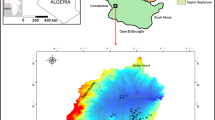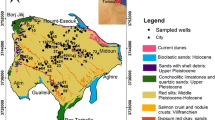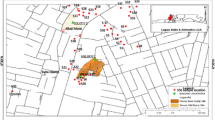Abstract
The impact of Attenda abattoir, Ogbomoso southwestern Nigeria on four water sources was investigated using geoelectrical imaging and microbiological analysis. 2D electrical resistivity imaging indicated groundwater contamination by leachate from the abattoir. Electrical resistivity values measured by the traverse run directly on the waste dump and other areas impacted by the waste from the abattoir are generally very low (6.68–16.7 Ωm) in comparison to other positions (135–288 Ωm). The total viable bacteria count of the water samples ranged from 0.49 × 106 to 2.85 × 108 cfu/ml and all samples are contaminated with coliforms with the most probable number (MPN)/100 ml ranging from 110 to ≥1,600 MPN/100 ml. Among bacteria isolated from the study site (n = 95), resistance to eight antibiotics ranged from 35.8% to 94%. In addition, 85% of Streptococcus agalactiae (n = 31) and Staphylococci (n = 9) showed haemolytic activity while 92% of all isolates showed β-lactamase activity. These results suggest that operations of the abattoir may impact negatively on surrounding aquatic ecosystem and endanger the health of surrounding residents who use water from the wells for domestic purposes. Furthermore, such aquatic ecosystems may serve as reservoir of antibiotic resistant bacteria.



Similar content being viewed by others
References
Adelowo, O. O., Fagade, O. E., & Oke, A. J. (2008). Prevalence of co-resistance to disinfectants and clinically relevant antibiotics in bacterial isolates from three hospital laboratory wastewaters in Southwestern Nigeria. World J. Microbiol. Biotechnol., 24, 1993–1997.
Adelowo, O. O., & Fagade, O. E. (2009). The tetracycline resistance gene tet39 is present in both Gram-negative and Gram-positive bacteria from a polluted river, southwestern Nigeria. Letters in Applied Microbiology, 48, 167–172.
Adelowo, O. O., Ojo, F. A., & Fagade, O. E. (2009). Prevalence of multiple antibiotic resistance among bacterial isolates from selected poultry waste dumps in Southwestern Nigeria. World Journal of Microbiology and Biotechnology, 25, 713–719.
Adesemoye, A. O., Opere, B. O., & Makinde, S. C. O. (2006). Microbial content of abattoir wastewater and its contaminated soil in Lagos, Nigeria. African Journal of Biotechnology, 5, 1963–1968.
American Public Health Association—APHA. (1998). Standard methods for the examination water and wastewater (20th ed.). Washington, DC: American Public Health Association.
Amidu, S. A., & Olayinka, A. I. (2006). Environmental assessment of sewage disposal systems using 2D electrical-resistivity imaging and geochemical analysis: a case study from Ibadan, Southwestern Nigeria. Environmental and Engineering Geoscience, 12, 261–272.
Andrews, J. M. (2007). BSAC standardized disc susceptibility testing method (version 6). Journal of Antimicrobial Chemotherapy, 60, 20–41.
Barrett, J. R. (2001). Livestock farming: eating up the environment? Environ. Health Perspectives, 109, 7.
Barrow, G. I., & Feltham, R. K. A. (1999). Cowan and Steel’s manual for the identification of medical bacteria (3rd ed.). United Kingdom: Cambridge University Press.
Biyela, P. T., & Bezuidenhout, C. C. (2004). The role of aquatic ecosystems as reservoirs of antibiotic resistant bacteria and antibiotic resistance genes. Water Science and Technology, 50, 45–50.
Bohnsack, J. F., Whiting, A. A., Martinez, G., Jones, N., Adderson, E. E., Detrick, S., et al. (2004). Serotype III Streptococcus agalactiae from bovine milk and human neonatal infections. Emerging Infectious Diseases, 10, 1412–1419.
Burlak, C., Hammer, C. H., Robinson, M. A., Whitney, A. R., McGavin, M. J., Kreiswrth, B. N., et al. (2007). Global analysis of community-associated methicillin-resistant Staphylococcus aureus exoproteins reveals molecules produced in vitro and during infection. Cellular Microbiology, 9, 1172–1190.
Cadmus, S.I.B., Olugasa, B.O., & Ogundipe, G.A.T. (1999). The prevalence and zoonotic importance of bovine tuberculosis in Ibadan, Nigeria. Proceedings of the 37th Annual Congress of the Nigerian Veterinary Medical Association. pp. 65–70.
De Mouy, D., Cavallo, J., Leclercq, R., Fabre, R., & Network, The Aforcopi-Bio. (2001). Antibiotic susceptibility and mechanisms of erythromycin resistance in clinical isolates of Streptococcus agalactiae: French multicenter study. Antimicrobial Agents and Chemotherapy, 45, 2400–2402.
Ebraheem, A. M., Senosy, M. M., & Dahab, K. A. (1997). Geoelectrical and hydrogeochemical studies for delineating ground-water contamination due to salt-water intrusion in the northern part of the Nile Delta, Egypt. Ground Water, 35, 216–222.
Ezeronye, O. U., & Ubalua, A. O. (2005). Studies on the effect of abattoir and industrial effluents on the heavy metals and microbial quality of Aba river in Nigeria. African Journal of Biotechnology, 4, 266–272.
Golet, E. M., Xifra, I., Siegrist, H., Alder, A. C., & Giger, W. (2003). Environmental exposure assessment of flouroquinolone antibacterial agents from sewage to soil. Environmental Science and Technology, 37, 3243–3249.
Gottschalk, B., Bröker, G., Kuhn, M., Aymanns, S., Gleich-Theurer, U., & Spellerberg, B. (2006). Transport of multidrug resistance substrates by the Streptococcus agalactiae hemolysin transporter. Journal of Bacteriology, 188, 5984–5992.
Hansen, B. M., & Hendriksen, N. B. (2001). Detection of enterotoxic Bacillus cereus and Bacillus thuringiensis strains by PCR analysis. Applied and Environmental Microbiology, 67, 185–189.
Harakeh, S., Yassine, H., & El-Fadel, M. (2006). Antimicrobial-resistant patterns of Escherichia coli and Salmonella strains in the aquatic Lebanese environments. Environmental Pollution, 143, 269–277.
Hayes, J. R., English, L. L., Carr, L. E., Wagner, D. D., & Joseph, S. W. (2004). Multiple-antibiotic resistance of Enterococcus spp. isolated from comercial poultry production environments. Applied and Environmental Microbiology, 70, 6005–6011.
Hæggman, S., Löfdahl, S., Paauw, A., Verhoef, J., & Brisse, S. (2004). Diversity and evolution of the class A chromosomal beta-lactamase gene in Klebsiella pneumoniae. Antimicrobial Agents and Chemotherapy, 48, 2400–2408.
Hernaiz, C., Picardo, A., Alos, J. I., & Gomez-Garces, J. L. (2003). Nosocomial bacteremia and catheter infection by Bacillus cereus in an immunocompetent patient. Clin Microbiol Infection, 9, 973–975.
Kayabali, K., Yuksel, F. A., & Yeken, T. (1998). Integrated use of hydrochemistry and resistivity methods in groundwater contamination caused by a recently closed solid waste site. Environmental Geology, 36, 227–234.
Lateef, A., Oloke, J. K., & Gueguimkana, E. B. (2005). The prevalence of bacterial resistance in clinical, food, water and some environmental samples in Southwestern Nigeria. Environmental Monitoring and Assessment, 100, 59–69.
Martinez, J. L., Fajardo, A., Garmendia, L., Hernandez, A., Linares, J. F., Martınez-Solano, L., et al. (2009). A global view of antibiotic resistance. FEMS Microbiology Reviews, 33, 44–65.
Massé, D. I., & Massé, L. (2000). Characterization of wastewater from hog slaughterhouses in Eastern Canada and evaluation of their in-plant wastewater treatment systems. Canadian Agricultural Engineering, 42, 139–146.
McArthur, J. V., & Tuckfield, R. C. (2000). Spatial patterns in antibiotic resistance among stream bacteria: effects of industrial pollution. Applied and Environmental Microbiology, 66, 3722–3726.
Motlová, J., Straková, L., Urbášková, P., Sak, P., & Sever, T. (2004). Vaginal and rectal carriage of Streptococcus agalactiae in the Czech Republic: incidence, serotypes distribution and susceptibility to antibiotics. The Indian Journal of Medical Research, 119, 84–87.
Okeke, I. N., & Edelman, R. (2001). Dissemination of antibiotic-resistant bacteria across geographic borders. Clinical Infectious Diseases, 33, 364–369.
Olayinka, A. I., Abimbola, A. F., Isibor, R. A., & Rafiu, A. R. (1999). A geoelectrical–hydrogeochemical investigation of shallow groundwater occurrence in Ibadan, southwestern Nigeria. Environmental Geology, 37, 31–39.
Olugasa, B.O., Cadmus, S.I.B., & Atsanda, N.N. (2000). Actualisation of strategies for beef quality control in South-Western Nigeria. Proceedings of the 10th International Congress on Animal Hygiene, vol. 1:67–71, July 2–6, 2000, Wijid Bij Vaasted, Animal Health Service, Maastricht, The Netherlands.
Prado, T., Pereira, W. C., Silva, D. M., Seki, L. M., Carvalho, A. P. D. A., & Asensi, M. D. (2008). Detection of extended-spectrum b-lactamase-producing Klebsiella pneumoniae in effluents and sludge of a hospital sewage treatment plant. Letters in Applied Microbiology, 46, 136–141.
Sangodoyin, A. Y. (1990). Fundamentals and trends of water services in a Nigerian urban settlement. International Journal of Environmental Education and Information, 9, 181–198.
Sangodoyin, A. Y., & Agbawhe, O. M. (1992). Environmental study on surface and groundwater pollutants from abattior effluents. Bioresource Technology, 41, 193–200.
Smith, S. I., Aboaba, O. O., Odeigha, P., Shodipo, K., Adeyeye, J. A, Ibrahim, A., et al. (2003). Plasmid profile of E. coli 0157:H7 from apparently healthy animals. African Journal of Biotechnology, 2, 322–324.
Standards Organization of Nigeria (SON). (2007). Nigerian standard for drinking water quality (p. 30). Lagos Nigeria: SON.
Tibbetts, J. (2001). Water world 2000. Environ Health Perspectives, 108, A69–A72.
van der Mee-Marquet, N., Fourny, L., Arnault, L., Domelier, A., Salloum, M., Lartigue, M., et al. (2008). Molecular characterization of human-colonizing Streptococcus agalactiae strains isolated from throat, skin, anal margin and genital body sites. Journal of Clinical Microbiology. doi:10.1128/JCM.00421-08.
Zeng, X., Kong, F., Wang, H., Darbar, A., & Gilbert, G. L. (2006). Simultaneous detection of nine antibiotic resistance-related genes in Streptococcus agalactiae using multiplex PCR and reverse line blot hybridization assay. Antimicrobial Agents and Chemotherapy, 50, 204–209.
Author information
Authors and Affiliations
Corresponding author
Rights and permissions
About this article
Cite this article
Adelowo, O.O., Akinlabi, I.A. & Fagade, O.E. Environmental impact assessment of Attenda abattoir, Ogbomoso southwestern Nigeria on surface and groundwater quality using geo-electrical imaging and microbiological analysis. Environ Monit Assess 184, 4565–4574 (2012). https://doi.org/10.1007/s10661-011-2285-2
Received:
Accepted:
Published:
Issue Date:
DOI: https://doi.org/10.1007/s10661-011-2285-2




